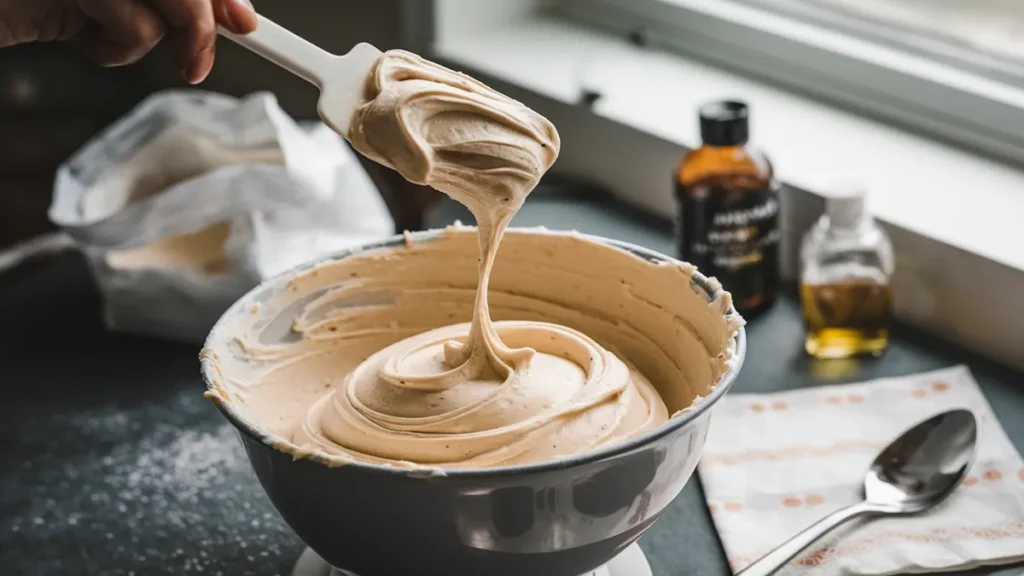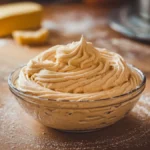
Almond buttercream frosting is an easy, homemade icing that adds a delicious nutty twist to cakes, cupcakes, and cookies. It’s rich in flavor and simple to prepare, making it a versatile choice for all kinds of baked goods. Having tested several versions, this one is by far the most balanced in flavor and texture. Looking to twist your frosting? Almond buttercream adds a subtle, nutty flavor that turns any dessert into something special — more exciting than plain vanilla or chocolate!
Whether you are a novice baker or an experienced pastry chef, this almond buttercream is a simple yet effective way to enhance your creations. The beauty of almond buttercream frosting lies in its simplicity. You only need a few basic ingredients and simple tools. In just a few minutes, your frosting is ready to go!
This frosting is perfect for beginners who want to impress friends and family with their baking skills.
Key Takeaways
- Almond buttercream frosting is easy to make, even for beginners
- The key ingredients for nutty buttercream are butter, powdered sugar, almond extract, and milk
- Step-by-step instructions include creaming the butter, adding powdered sugar, and mixing in almond extract and milk
- Tips for perfecting your frosting include using room temperature ingredients and adjusting the consistency with more milk or powdered sugar
- This almond-flavored frosting is a smooth and nutty buttercream that’s perfect for cupcakes, cookies, or any baked goods needing a sweet twist, and filling macarons.
Ingredients and Equipment Needed
Key Ingredients
To make this almond-flavored frosting, you’ll only need a few baking staples:
butter, powdered sugar, almond extract, milk or cream, and a pinch of salt.
➡️ Check the full recipe card at the end of this article for exact quantities and instructions.
Equipment Needed
You’ll find all the equipment listed in the full recipe below 👇
Just the basics: a bowl, mixer, and spatula.
Optional Tools for Decorating
If you have a piping bag and various tips, feel free to get creative with your frosting designs.
Not essential though a simple knife or offset spatula works great for spreading.
How to Make Almond Buttercream Frosting (Easy Step-by-Step Recipe)
To begin making almond icing, bring your unsalted butter to room temperature Want to make it without butter? Try this vegan almond frosting instead! This step is crucial as softened butter blends more easily with the powdered sugar, resulting in a smoother texture. Once the butter is soft, place it in your mixing bowl and beat it with an electric mixer on medium speed until it becomes creamy and light in color.
This process usually takes about 2-3 minutes. Next, gradually add the powdered sugar to the creamed butter, mixing on low speed to prevent a sugar cloud from forming. Once you’ve added all the sugar, increase the speed to medium and keep mixing until the mixture becomes fluffy.
At this point, add the almond extract and a pinch of salt. Mix again until everything is well combined. If the frosting appears too thick, you can add a tablespoon of milk or cream to achieve your desired consistency.
Conversely, if it’s too thin, simply add more powdered sugar until it thickens up.
Best Tips to Perfect Almond Buttercream Texture and Flavor
| Technique | Description |
|---|---|
| Room Temperature Butter | Allow butter to come to room temperature before using for a smoother frosting. |
| Gradually Add Sugar | Add powdered sugar gradually to avoid lumps in the frosting. |
| Use High-Quality Ingredients | Using high-quality butter and vanilla extract can greatly improve the richness of your frosting. |
| Whip Until Fluffy | Whip the frosting for several minutes until it becomes light and fluffy. |
| Adjust Consistency | Add milk or powdered sugar to adjust the consistency of the frosting as needed. |
Achieving the perfect almond buttercream frosting requires attention to detail and a few helpful tips. One important aspect is to ensure that your butter is at the right temperature; if it is too cold, it won’t blend well, and if it is too warm, it can become greasy. Additionally, when adding powdered sugar, do so gradually to avoid clumping and ensure an even mix.
If you find that your frosting is too sweet for your taste, consider adding a bit more salt or even a splash of lemon juice to balance the taste. Another useful tip is to sift your powdered sugar before adding it to the butter. Sifting helps eliminate any lumps and results in a smoother frosting.
If you want to experiment with aroma, consider incorporating other extracts, such as vanilla or hazelnut, alongside the almond extract for a more complex taste profile. Lastly, always taste your frosting as you go; this will help you adjust the sweetness and flavor according to your preference.
How to Use Almond Buttercream Frosting on Cakes, Cookies, & More
You can use almond buttercream frosting in various creative ways beyond just topping cakes and cupcakes. One popular application is as a filling for sandwich cookies or macarons, where its rich flavor complements the delicate textures beautifully. You can also use it as a dip for fresh fruits like strawberries or apple slices, It’s also a great choice for decorating a heart-shaped cake for birthdays or romantic celebrations.
For those looking to elevate their dessert presentations, consider using almond buttercream for decorating layer cakes or as a filling between cake layers. Its smooth consistency makes it ideal for piping intricate designs on cupcakes or cookies. Additionally, you can mix in food coloring to match specific themes or occasions, allowing for visually stunning creations that are sure to impress guests at any gathering. Almond buttercream pairs perfectly with trendy desserts like bento cake, offering both taste and visual appeal in a mini, personalized treat.
How to Store Almond Buttercream Frosting (Fridge & Freezer Guide)
Proper storage of almond buttercream frosting is essential for maintaining its freshness and quality. If you have extra frosting, keep it in a sealed container in the fridge. It can typically last for up to two weeks when refrigerated.
Before using it again, allow it to come back to room temperature and give it a good stir or re-whip with an electric mixer to restore its creamy texture. If you want to extend its shelf life even further, consider freezing the almond buttercream frosting. Place it in a freezer-safe container or zip-top bag, making sure you remove all the air before sealing.
Frozen frosting can last for up to three months. When you’re ready to use it, simply thaw it in the refrigerator overnight and then bring it back to room temperature before re-whipping.
Conclusion and Final Thoughts
Almond buttercream frosting is an easy yet delicious addition to any baker’s repertoire. With its simple ingredients and straightforward preparation process, even those with little experience can create a delightful frosting that enhances their baked goods. By following the steps outlined above and incorporating some helpful tips, you can achieve a smooth and flavorful almond buttercream that will impress anyone who tastes it.
Whether you’re using it for special occasions or simply indulging in homemade treats, almond buttercream frosting offers versatility and creativity in your baking endeavors. So gather your ingredients and equipment, and embark on this delightful journey into the world of almond-flavored sweetness!
FAQs
What is almond buttercream frosting?
Almond buttercream frosting is a delicious and creamy frosting made with almond extract, butter, powdered sugar, and milk. It has a rich and nutty aroma that pairs well with a variety of baked goods.
What ingredients are needed to make almond buttercream frosting?
To make almond buttercream frosting, you will need butter, powdered sugar, almond extract, milk, and a pinch of salt. These simple ingredients come together to create a smooth and flavorful frosting.
What equipment is needed to make almond buttercream frosting?
You will need a stand mixer or hand mixer, a mixing bowl, measuring cups and spoons, and a rubber spatula to make almond buttercream frosting. These basic kitchen tools will help you achieve a smooth and creamy consistency.
What are the step-by-step instructions for making almond buttercream frosting?
The step-by-step instructions for making almond buttercream frosting include creaming the butter, adding the powdered sugar and almond extract, and gradually adding the milk until you reach the desired consistency. The process is simple and easy to follow, even for beginners.
What are some tips and tricks for perfecting almond buttercream frosting?
Some tips for perfecting almond buttercream frosting include using room temperature butter, sifting the powdered sugar to avoid lumps, and adding the milk gradually to achieve the right consistency. Additionally, adjusting the amount of almond extract to taste can help customize the flavor.
What are some creative ways to use almond buttercream frosting?
Almond buttercream frosting can be used to frost cakes, cupcakes, cookies, and other baked goods. It can also be used as a filling for macarons or sandwich cookies or as a topping for brownies or bars. The nutty flavor of the frosting adds a delicious twist to any dessert.
How should almond buttercream frosting be stored, and what is its shelf life?
Almond buttercream frosting should be stored in an airtight container in the refrigerator. It can be kept for up to 1 week, but it is best used within a few days for optimal freshness and flavor. Before using leftover frosting, allow it to come to room temperature and re-whip it for a smooth consistency.
What are some final thoughts on making almond buttercream frosting?
In conclusion, almond buttercream frosting is both versatile and delicious — and you can whip it up at home with just a few simple ingredients. Whether you’re new to baking or a seasoned pro, this frosting complements any dessert and can be tailored to suit your taste. With the right techniques and a little creativity, you can create beautiful and tasty treats with almond buttercream frosting.
📋 Looking for a quick summary?
Here’s the complete almond buttercream recipe in one glance:
Easy almond frosting recipe
Equipment
- Electric hand mixer or stand mixer
- Mixing bowl
- Rubber spatula
- Measuring cups and spoons
Materials
- 1 cup unsalted butter room temperature (226g)
- 1 teaspoon vanilla extract 4g
- 1 teaspoon almond extract 4g
- 1/4 teaspoon fine salt 2g
- 3 1/2 cups powdered sugar 454g or a 1 lb. box
- 1 tablespoon heavy cream or whipping cream 15g
Instructions
- In a large bowl, beat the butter on medium speed for about 1 minute until smooth and creamy.
- Add vanilla extract, almond extract, and salt. Mix on low speed until well blended.
- Gradually add powdered sugar and cream while mixing on low, scraping down the sides as needed.
- Once combined, increase speed and beat until light and fluffy (1-2 minutes).
- Adjust consistency: add more cream if too thick or more powdered sugar if too thin.
- Stir by hand with a spatula for extra smoothness. Use immediately or store as noted.
Notes
- Ensure the butter is at room temperature before making the frosting.
- If your powdered sugar contains cornstarch (as most brands in the US do), there’s no need to sift it.
- Use good-quality almond extract for the best flavor.
- For a smoother frosting, mix on the lowest speed at the end of the process for a couple of minutes to remove any extra air incorporated during mixing.
- Store the frosting in an airtight container at room temperature for 1-2 days, in the fridge for up to a month, or in the freezer for up to 3 months. Stir well before use if stored.
Tested this recipe? Share your creations in the comments
